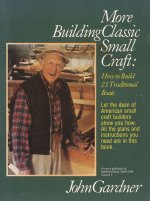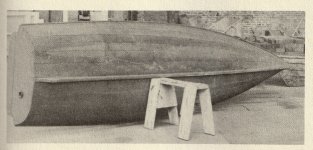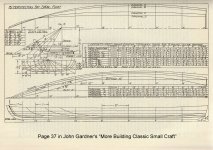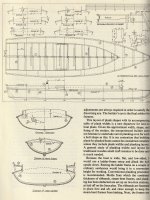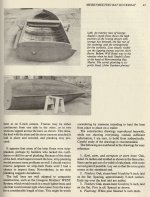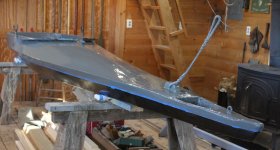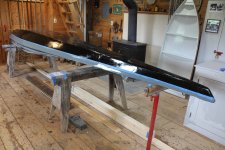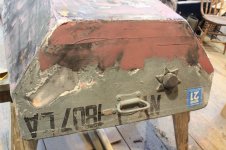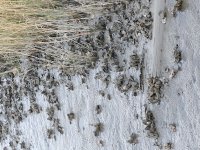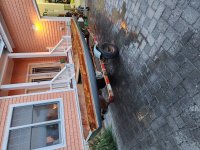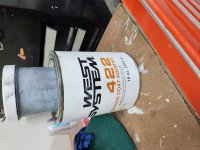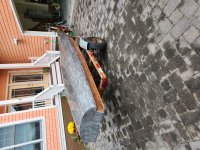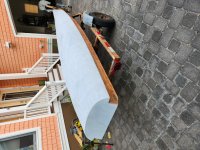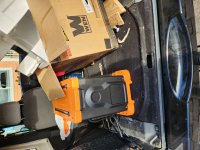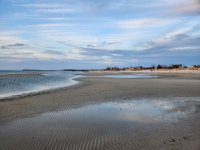Richard Kassner
New member
Hello All,
I am restoring a glass over wood Merrymeeting Bay Gunning Float and I have some questions that owners of such boats maybe able to help me with.
A. HOW LARGE SHOULD A FLOAT'S SKEG BE?
My Float is 15 feet 5 inches long (according to the title). The Transom is 3 feet wide by 11 3/4 inches high. The Float is 44 inches wide amid ship.
The original skeg is 25 and 1/2 inches long, 1/4 inch wide, by 2 1/2 inches high. Frankly it appears puny to me. See picture below.
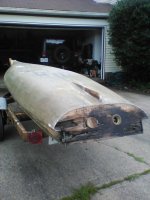
I had a very difficult time getting the boat to "track" when sculling.
I decided to make a new skeg as the original skeg was "cupped." The new skeg is 26 inches long, 3/4 inches wide, and 3 5/8th inches high. The new skeg is larger than the old skeg. See picture below.
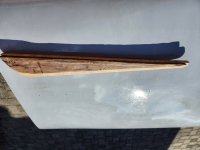
While larger than the old skeg, the new skeg appears smallish compared to the boat. See picture below.
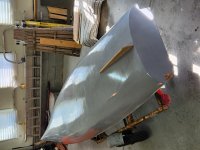
I "believe" that I am limited in making the skeg higher due to the risk of the skeg hitting something if the skeg protrudes beyond the centerline of the hull. The centerline of the hull to the transom is 4 and 1/8th inches high -see Picture below. This is why I made the new skeg only 3 5/8th inches high. (I wanted 1/2 inch clearance.)

I am wondering if I should not have made the skeg wider. For example, using 6/4 quarter sawn white oak instead of 3/4 inch white oak. I was concerned that the 1 1/4 inch wide Skeg would fail to sit "flat" on the hull as the hull gradually slopes starboard and port from the centerline. (I may have been too cautious.)
QUESTION: Would a wider Skeg help the boat track better -thereby making it easier to scull?
I could increase the height of the Skeg "if" I added a Keel down the centerline of the hull. For example, if I attached a 1 inch high by 1 inch wide keel and attach the 3 5/8th inch Skeg onto the Keel thereby raising the Skeg to 4 5/8th inches while maintaining the 1/2 inch clearance below the centerline.
QUESTION: Would a Higher Skeg help the boat track better -thereby making it easier to scull?
OR Is it just a matter of more practice regardless of the size of the Skeg? (After all the original Skeg was only 2 1/2 inches tall and built by someone who knew more about Merrymeeting Bay Gunning Floats than myself!)
B. ARE THERE KEELS AND HULL STRAKES ON SCULL FLOATS?
My Float doesn't have any nor do I recall seeing them on other Scull Floats.
Yet Merrymeeting Bay is in Maine and when I visited Maine as a child I remember rocks on the beach.
My Float's hull has been damaged at least twice by rocks. Both times amid ship with damage on the starboard and port side of the Float.
See Picture below of Starboard side of the Float -you might be able to make out the white fiberglass laminate repair at the Float's center. This was a good repair.
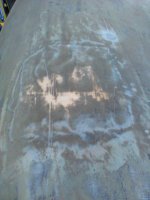
See Pictures below of the Port Side of the Float. (Notice the smashed wood strips. No fiberglass laminate was laid over the repair. Only some type of white filler and paint was used -which provided the opportunity for osmosis. A weak resin was used to glue over the damaged wood strips. I repaired them with Wood Epox.)
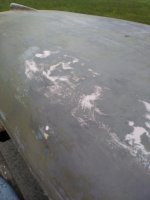
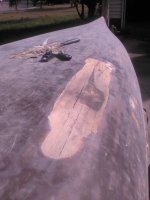
I would think that Keels and Hull Strakes would provide some protection of the hull from rocks and stones. Further, I would think these protrusions would help the Float track.
QUESTION: Do Keels and Hull Strakes impede Floats in "skinny" water whereby these protrusions more often get the Float "stuck in the mud" or "hit" rocks and stones?
QUESTION: Do Keels and Hull Strakes make it harder to Scull the Float in turns around creeks and such and this is why I do not see them on Floats?
I wonder "if" I am just thinking to build a set of "Training Wheels" on my Gunning Float by adding Hull Strakes, a Keel, and making the Skeg higher when what I really need to do is practice, practice, practice?

Any input would be most welcome.
Cheers
I am restoring a glass over wood Merrymeeting Bay Gunning Float and I have some questions that owners of such boats maybe able to help me with.
A. HOW LARGE SHOULD A FLOAT'S SKEG BE?
My Float is 15 feet 5 inches long (according to the title). The Transom is 3 feet wide by 11 3/4 inches high. The Float is 44 inches wide amid ship.
The original skeg is 25 and 1/2 inches long, 1/4 inch wide, by 2 1/2 inches high. Frankly it appears puny to me. See picture below.

I had a very difficult time getting the boat to "track" when sculling.
I decided to make a new skeg as the original skeg was "cupped." The new skeg is 26 inches long, 3/4 inches wide, and 3 5/8th inches high. The new skeg is larger than the old skeg. See picture below.

While larger than the old skeg, the new skeg appears smallish compared to the boat. See picture below.

I "believe" that I am limited in making the skeg higher due to the risk of the skeg hitting something if the skeg protrudes beyond the centerline of the hull. The centerline of the hull to the transom is 4 and 1/8th inches high -see Picture below. This is why I made the new skeg only 3 5/8th inches high. (I wanted 1/2 inch clearance.)

I am wondering if I should not have made the skeg wider. For example, using 6/4 quarter sawn white oak instead of 3/4 inch white oak. I was concerned that the 1 1/4 inch wide Skeg would fail to sit "flat" on the hull as the hull gradually slopes starboard and port from the centerline. (I may have been too cautious.)
QUESTION: Would a wider Skeg help the boat track better -thereby making it easier to scull?
I could increase the height of the Skeg "if" I added a Keel down the centerline of the hull. For example, if I attached a 1 inch high by 1 inch wide keel and attach the 3 5/8th inch Skeg onto the Keel thereby raising the Skeg to 4 5/8th inches while maintaining the 1/2 inch clearance below the centerline.
QUESTION: Would a Higher Skeg help the boat track better -thereby making it easier to scull?
OR Is it just a matter of more practice regardless of the size of the Skeg? (After all the original Skeg was only 2 1/2 inches tall and built by someone who knew more about Merrymeeting Bay Gunning Floats than myself!)
B. ARE THERE KEELS AND HULL STRAKES ON SCULL FLOATS?
My Float doesn't have any nor do I recall seeing them on other Scull Floats.
Yet Merrymeeting Bay is in Maine and when I visited Maine as a child I remember rocks on the beach.
My Float's hull has been damaged at least twice by rocks. Both times amid ship with damage on the starboard and port side of the Float.
See Picture below of Starboard side of the Float -you might be able to make out the white fiberglass laminate repair at the Float's center. This was a good repair.

See Pictures below of the Port Side of the Float. (Notice the smashed wood strips. No fiberglass laminate was laid over the repair. Only some type of white filler and paint was used -which provided the opportunity for osmosis. A weak resin was used to glue over the damaged wood strips. I repaired them with Wood Epox.)


I would think that Keels and Hull Strakes would provide some protection of the hull from rocks and stones. Further, I would think these protrusions would help the Float track.
QUESTION: Do Keels and Hull Strakes impede Floats in "skinny" water whereby these protrusions more often get the Float "stuck in the mud" or "hit" rocks and stones?
QUESTION: Do Keels and Hull Strakes make it harder to Scull the Float in turns around creeks and such and this is why I do not see them on Floats?
I wonder "if" I am just thinking to build a set of "Training Wheels" on my Gunning Float by adding Hull Strakes, a Keel, and making the Skeg higher when what I really need to do is practice, practice, practice?

Any input would be most welcome.
Cheers


